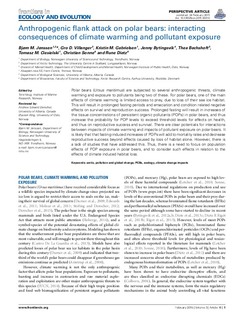Anthropogenic flank attack on polar bears: interacting consequences of climate warming and pollutant exposure
Jenssen, Bjørn Munro; Villanger, Gro Dehli; Gabrielsen, Kristin Møller; Bytingsvik, Jenny; Bechshoft, Thea; Ciesielski, Tomasz Maciej; Sonne, Christian; Dietz, Rune
Journal article, Peer reviewed
Permanent lenke
http://hdl.handle.net/11250/284767Utgivelsesdato
2015Metadata
Vis full innførselSamlinger
- Institutt for biologi [2575]
- Publikasjoner fra CRIStin - NTNU [38127]
Sammendrag
Polar bears (Ursus maritimus) are subjected to several anthropogenic threats, climate warming and exposure to pollutants being two of these. For polar bears, one of the main effects of climate warming is limited access to prey, due to loss of their sea ice habitat. This will result in prolonged fasting periods and emaciation and condition related negative effects on survival and reproduction success. Prolonged fasting will result in increases of the tissue concentrations of persistent organic pollutants (POPs) in polar bears, and thus increase the probability for POP levels to exceed threshold levels for effects on health, and thus on reproductive success and survival. There are clear potentials for interactions between impacts of climate warming and impacts of pollutant exposure on polar bears. It is likely that that fasting-induced increases of POPs will add to mortality rates and decrease reproductive success beyond effects caused by loss of habitat alone. However, there is a lack of studies that have addressed this. Thus, there is a need to focus on population effects of POP exposure in polar bears, and to consider such effects in relation to the effects of climate induced habitat loss.
Beskrivelse
- Published article
